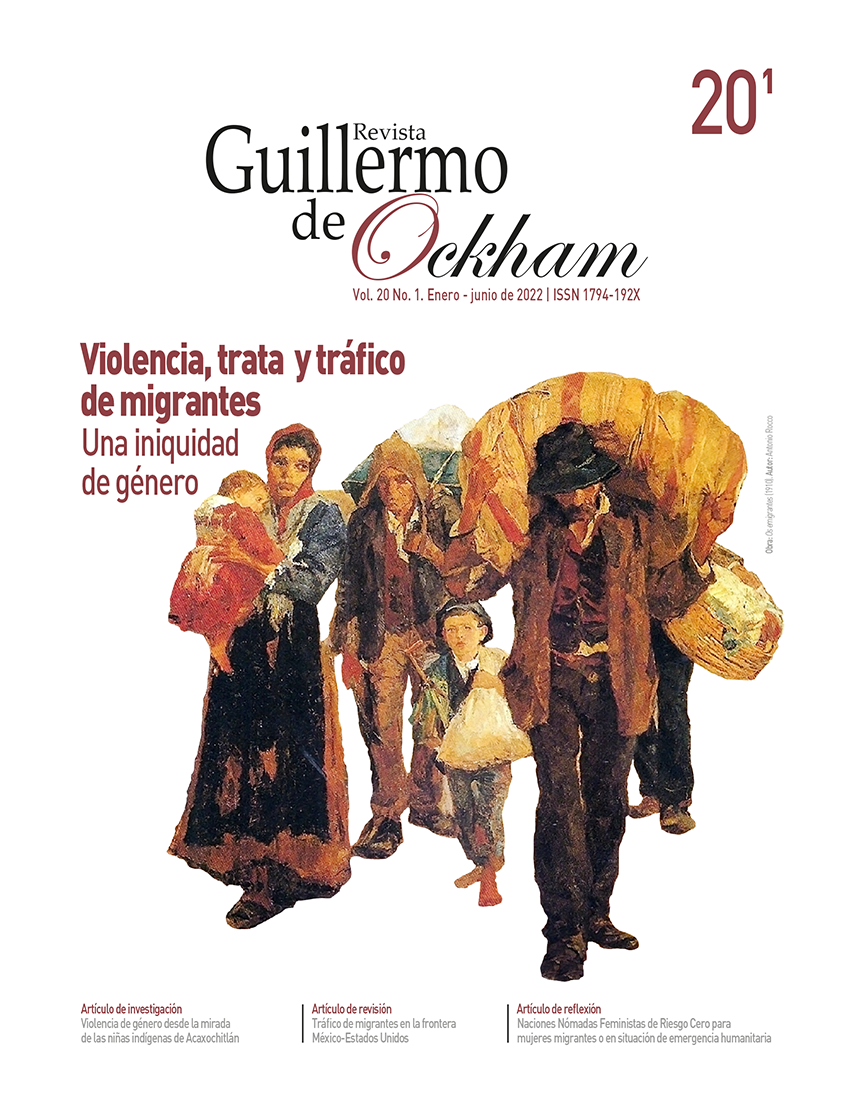The Revista Guillermo de Ockham provides an immediate and open access to its content, based on the principle of offering the public a free access to investigations to provide a global interchange of knowledge.
Unless otherwise established, the contents of this journal has a license with Creative Commons Attribution-NonCommercial-NoDerivatives 4.0 International (CC BY-NC-ND 4.0) http://creativecommons.org/licenses/by-nc-nd/4.0/
- Attribution: You must give appropriate credit, provide a link to the license, and indicate if changes were made. You may do so in any reasonable manner, but not in any way that suggests the licensor endorses you or your use.
- NonCommercial: You may not use the material for commercial purposes.
- NoDerivatives: If you remix, transform, or build upon the material, you may not distribute the modified material.
- No additional restrictions: You may not apply legal terms or technological measures that legally restrict others from doing anything the license permits.
Resumo
Os estudos de gênero levantaram a necessidade de discutir em profundidade as implicações da prostituição à luz dos direitos humanos das mulheres. A teoria abolicionista se posiciona a partir da defesa da dignidade das pessoas e sem criminalizar quem se encontra em situação de prostituição, torna visível esta como uma prática que deve ser erradicada, pois constitui uma das mais terríveis estratégias de exploração e violência contra as mulheres. O objetivo desta pesquisa foi compreender as percepções que as mulheres têm sobre a violência que vivenciam em seus corpos no ato da prostituição e as estratégias que implementam para resistir ou estabelecer limites nesses encontros eróticos desiguais e violentos. A pesquisa foi qualitativa com escopo descritivo, foram entrevistadas onze mulheres que atualmente se encontram em situação de prostituição, foi aplicada análise de conteúdo às transcrições. Os resultados mostram que todas acabaram na prostituição após buscarem outras opções de renda e veem a prostituição como uma situação temporária da qual sairão para ingressar em outras atividades de trabalho e / ou estudo. Não percebem a violência que permeia os espaços em que seus serviços são consumidos, por isso suas estratégias de contenção de riscos são limitadas, assumem visões mercantilistas sobre seus corpos sem considerar que há uma desigualdade de poderes na interação com homens predadores.
Palavras-chave:
Referências
Callás, C. (2017). Sexo y dinero. Lectorum.
Castro, N., Escoto, A., Florez, N., Nava, I., Navarrete, E. L., Padrón, M., Román, P. & Sosa, M. (2021). México y su población ocupada al inicio de la pandemia por COVID-19: Entre la esencialidad y el riesgo de trabajo. Revista Latinoamericana de Población, Vol. 15, Nº 29, pp. 166-210.
Daich, D. (2012) ¿Abolicionismo o reglamentarismo? Aportes de la antropología feminista para el debate local sobre la prostitución. Runa, Vol. 33, Nº 1, pp. 71-84.
Diario Oficial de la Federación (8 de marzo de 2018). Ley General de Acceso de las Mujeres a una Vida Libre de Violencia.
Díez Gutiérrez, E. J. (2009). Prostitución y Violencia de Género. Nómadas. Critical Journal of Social and Juridical Sciences, Vol. 24, Nº 4.
Farley, M. (2003) Prostitution and the Invisibility of Harm. Women & Therapy, Vol. 26, No. 3/4, pp. 247-280. DOI: 10.1300/J015v26n03_06
Katz, I. M. (2013). ¿Qué tan liberal es usted? Coyoacán, México.
Lagarde, M. (2015). Los cautiverios de las mujeres: madresposas, monjas, putas, presas y locas. (2ª ed.). México, D.F.: Siglo XXI Editores.
Lagarde, M. y Valcárcel, A. (2011). Feminismo, género e igualdad. España: Pensamiento Iberoamericano.
MacKinnon, C. (2014). Feminismo inmodificado: Discursos sobre la vida y el derecho. Siglo XXI.
Monárrez, J. (2000). La cultura del feminicidio en ciudad Juárez, 1993-1999. Frontera norte, Vol. 12, No. 23, pp. 87-117.
Montiel, O. (2013). El lado obscuro del México profundo: La estructura básica de la explotación sexual y las lógicas de reproducción social comunitaria como parte del proceso de proxenitización en una región rural. México, D.F.: CIESAS.
Núñez, L. (2021). Prostitución y dictadura: Las retóricas del feminismo abolicionista de Buenos Aires. A&H, Revista de Artes, Humanidades y Ciencias Sociales, No. 14, pp. 191-219.
Organización de las Naciones Unidas para la Educación, la Ciencia y la Cultura [UNESCO], (19 de octubre de 2005). Declaración universal sobre Bioética y Derechos Humanos. http://portal.unesco. org/es/ev.php-URL_ID=31058&URL_DO=DO_TOPIC&URL_SECTION=201.html
Organización Panamericana de la salud [OPS] y Consejo de Organizaciones Internacionales de las Ciencias Médicas [OPS], (2017). Pautas éticas internacionales para la investigación relacio- nada con la salud con seres humanos. https://cioms.ch/wp-content/uploads/2017/12/CIOMS- EthicalGuideline_SP_INTERIOR-FINAL.pdf
Periódico Oficial del Estado “Plan de San Luis” (10 de octubre de 2017). Ley de Acceso de las Mujeres a una Vida Libre de Violencia del Estado de San Luis Potosí.
Prieto, Mariana, Rangel, Y., & Navarro, U. (2021). Controlar, proteger y defender el cuerpo, la gestión de una misma en la prostitución. La ventana. Revista de estudios de género, Vol. 6, No. 53. pp. 147-181.
Valdés, M. (2005). La feminización de la pobreza. Un problema global. Mujer salud/red de salud de las mujeres latinoamericanas y del caribe, pp. 72-80.

 Perfil Google Scholar
Perfil Google Scholar






























